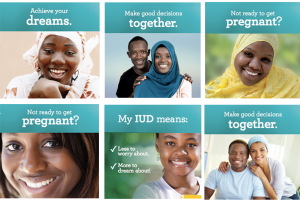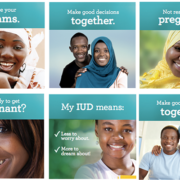Your Questions on LARCs – Answered
 The Health Communication Capacity Collaborative (HC3) recently hosted a webinar to explore important milestones surrounding youth and long-acting reversible contraceptive methods (LARCs), strategies for improving policies, tips for empowering youth-friendly service providers and social and behavior change communication (SBCC) tools for promoting conversation between providers and youth.
The Health Communication Capacity Collaborative (HC3) recently hosted a webinar to explore important milestones surrounding youth and long-acting reversible contraceptive methods (LARCs), strategies for improving policies, tips for empowering youth-friendly service providers and social and behavior change communication (SBCC) tools for promoting conversation between providers and youth.
The highly engaging presentations led to more questions than time allowed, so presenters Fariyal Fikree, Senior Research Advisor, Evidence to Action Project (E2A); Rena Greifinger, Technical Advisor for Youth and Girls, PSI; and Allison Mobley, Family Planning Team Lead, HC3 answered those questions here.
Materials mentioned in the answers below can be found in this post, New Materials Help Providers Counsel Young Women on the Benefits of LARCs.
Questions/Answers
How have youth, family and community been sensitized to increasing youth access to LARCs?
Fariyal Fikree: The Ethiopia “LARCs and Youth” study has a peer-educator intervention that I did not present. Peer educators in the intervention arm of the study following a three day LARC specific training sensitized youth on dispelling LARC myths and misperceptions and referring potential young clients to the YFS centers where the LARC trained YFS providers counseled and offered all reversible contraceptive methods.
How easy is it for providers to adopt the “Maria” approach, i.e., starting with LARCs, vis-a-vis methods that are popular or preferred in a given setting?
Rena Greifinger: I think that this will be easier or harder depending on the provider, the context and the culture. If this is a provider that is already a champion for LARCs and/or already a champion for youth and contraception, then it will likely be much easier for him/her to adjust the way in which he/she counsels. However, if he/she is resistant to young people using LARCs, it will have to take a lot more training, supervision and support. In many places, providers aren’t yet convinced of the safety and efficacy of LARCs for youth, so they are hesitant to counsel on them. In other places, providers aren’t confident providing LARCs – they take more time, more precision and require more clinical training. There can be more mishaps/complications. If providers don’t do many LARC provisions, they become less confident providing them and will then be less eager to counsel about them. Still, other providers feel they are being client-centered and respond immediately when a client comes in asking for a specific method – usually a short-acting method. Many young women hear about short-acting methods from their friends – especially pills and injections – and will come to the provider asking specifically for one. Rather than provide comprehensive counseling, the provider will provide that method. None of this is wrong, per se, but it limits the opportunity for the provider to educate the young woman about all of her options.
One of the challenges we are facing here with providers in Haiti is that they start with the most popular methods, i.e., injectable contraception, and often stop there.
Rena Greifinger: Exactly! And we want young women to choose whatever method is right for them. But in order to make those decisions, they need to have full information about all of the methods that are available. Starting with LARCs in the counseling session makes a lot of intuitive sense as they are most effective.
We’ve also noticed providers say something to the effect of “for you, I recommend the pill” instead of allowing the client to drive the decision-making.
Rena Greifinger: Agreed, this is very common. All over the world, there is a certain power and prestige attached to being a health provider. And that power is even more pronounced when the client is young. We are asking providers, in many ways, to shift the cultural mindset attached to healthcare – providers are there certainly as experts and to give accurate and appropriate information. However, they are not there to tell clients what to do, but rather to provide full information and help the client make a decision that they feel comfortable with.
Fariyal Fikree: I agree with Rena’s comments. Counseling and the counseling approach for young clients is a significant factor that should be given greater attention.
Turning the presentation of methods means that the client has a chance to really focus on the LARC…
Rena Greifinger: In many places where we work, young people – even all people – have not heard of LARCs. So just by informing them of what LARCs are, how they work, the benefits and the drawbacks, helps to open up the possibilities for a young client. She may still choose a different method – and that is completely fine – but it at least helps her know that other methods are out there if the one that she chooses ends up not working for her (or if her life situation changes).
Do we need a separate service area for young people (separate than the routine service area/room) in the facility?
Rena Greifinger: No, you don’t. There is no single recipe for youth-friendly health services. What is most important about the service is that providers treat clients with respect, dignity and without judgment. When young people are asked about what is most important to them when it comes to health services, they say “privacy, confidentiality and respect.” The health provider can make all the difference! Pathfinder International’s E2A project published a great tool called “Thinking Outside the Separate Space” which can help you think through the different service delivery options for youth-friendly health services and what might be easiest and best for your context. You will see that while the separate area/room can be something that is “nice to have,” it is certainly not a “need to have.” PSI also has a nice resource on youth-friendly health services called “Making Your Health Services Youth-Friendly.” Check out the graphic on page 4 which can help explain how providers are the foundation of any youth-friendly service.
Fariyal Fikree: I agree with Rena’s comments. What is significant is that providers receive appropriate training to treat all clients but especially young clients irrespective of marital status with respect, dignity and without judgement and provide these services respecting the clients need for “confidentiality.” In Ethiopia, the IFHP+ program addressed these issues in a separate room run by provider/s trained to be youth-friendly.
Is there any concern around informed consent on LARC vs short-acting methods for young women?
Rena Greifinger: I am not entirely sure what is being asked here – whether you are talking about the need for consent from an adult (parent or partner) or just whether the informed consent process is different for different methods. I am not familiar with the laws in every country, but national laws should be your guide. There are many countries that have laws stating that all women of reproductive age (usually 15 to 49) should have access to the full range of contraceptive methods and be able to consent for themselves. However, we know that this does not always happen in practice.
Has anyone worked with adolescents on any family planning projects?
Fariyal Fikree: The Ethiopia “LARCs and Youth” study was conducted in the implementation platform of IFHP+ adolescent and youth program. Please contact Worknesh Kereta (WKereta@pathfinder.org) for additional details.
Is there a place that we can download the posters, brochures?
Allison Mobley: Yes, the LARC posters and brochures can be downloaded from the HC3 website, http://healthcommcapacity.org/new-materials-help-providers-counsel-young-women-benefits-larcs/
Has a different version been pilot tested in Latin America?
Allison Mobley: Because this activity’s focus was (Anglophone) Sub-Saharan Africa, no pilot activities are planned for other regions. Pretests of the materials were conducted in Malawi (in English) and Nigeria (in English, Hausa and Yoruba). We welcome organizations to pilot in Latin American countries.
Have studies been done in sub-Saharan Africa to ask young women what they value most in a contraceptive method? I was surprised to see that the HC3 brochure didn’t list the quick return to fertility as one of the 6 top benefits of LARCs (especially compared to injectables). Instead the brochure simply said LARCs are “removable,” without highlighting the quick return to fertility after removal. We know that myths that LARCs cause sterility are a huge and common problem across countries. I also see that many providers mistakenly believe that implants, in particular, significantly delay return to fertility. I imagine that youth might be more interested in LARCs if we highlighted the quick return to fertility…Thoughts?
Allison Mobley: Our formative research for this activity focused more on the barriers around youth and LARC use, but we did find that many youth feared that their unsupportive parents or partners might find out about their contraceptive use. This is why the brochure and a poster in the series emphasize the “privacy” of LARCs, encouraging young women to evaluate whether a LARC might be a good choice for them. Regarding return to fertility, we address this in less technical terms to be easily understood by youth. Under the “6 reasons to think about an IUD or implant” in the brochure, for example, #5 reads LARCs are “removable when you’re ready to get pregnant.” Additional information about the return to fertility is included in the middle section of the brochure under “Can it be removed?” and the response is “Yes. When the IUD or implant is removed by a trained health provider, a woman can become pregnant right away.” The poster series also touches on this theme, and we emphasize that LARCs do not cause sterility in the video discussion guide for providers.
How do you suggest distributing the provider video in under developed countries where access to IT facilities are limited?
Allison Mobley: The video can be downloaded onto a computer or flash drive and shown on a computer or TV screen. Locally, an NGO or health center staff can do this when the connection is strong and can share the file onto more flash drives as needed. At the district or country level, it might be helpful if larger NGOs with branch offices or Ministries assist with download and dissemination.
Why did the team choose posters and brochures? What about literacy barriers?
Allison Mobley: Posters and brochures were developed for this first stage to reach youth and encourage them to talk with a healthcare provider. If a client sees the poster or brochure in the clinic, it could prompt her to ask questions about LARCs; and the provider can use the poster and brochure as job aids in their counseling sessions.
Additional Questions
If you have any additional questions or comments on the presentations, join the presenters on Springboard for Health Communication professionals, an online social network. To post a question or comment, sign into your existing account or register if you are a new member, then go to the Discussions tab, then Family Planning, then Encouraging LARC Discussions among Providers and Youth.
HC3’s next webinar is: Healthy Timing and Spacing of Pregnancy’s Forgotten Audiences: Addressing Pregnancy Among Advanced Maternal Age (AMA) and High Parity (HP) Women
May 25, 2016, 9:00 am – 10:00 am EDT
More information/register




Leave a Reply
Want to join the discussion?Feel free to contribute!